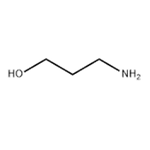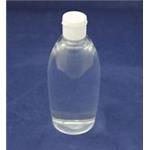clear colourless to very slightly yellow liquid
3-Amino-1-propanol is used in the production of anionic emulsifiers, nonionic polyethylene emulsions. Its salts such as hydrochloride, nitrate, sulfate, phosphate are used for the balanced curing action with selected textile resins. It is used as a starting material in the preparation of beta-lactam antibiotics, humectants for foods and cosmetics. It acts as a corrosion inhibitor and finds application in water treatment, metal treatment and absorption of carbon dioxide gas.
3-Amino-1-propanol was used in the synthesis of di-tert-butyl aminopropanol derivative.
ChEBI: 3-aminopropan-1-ol is a member of the class of propanolamines that is propane with a hydroxy substituent at C-1 and an amino substituent at C-2, making it both a primary amine and a primary alcohol. It is a primary alcohol, a primary amine and a propanolamine.
Colorless to pale yellow liquid with a fishy odor. Less dense than water. Melting point 12.4°C (54°F). Moderately toxic by ingestion.
3-Aminopropanol neutralizes acids to form salts plus water in an exothermic reaction. May be incompatible with isocyanates, halogenated organics, peroxides, phenols (acidic), epoxides, anhydrides, and acid halides. Reacts with strong reducing agents, such as hydrides to generate flammable gaseous hydrogen.
If inhaled may be harmful. Contact may cause burns to skin and eyes. (Organic base.)
Flammability and Explosibility
Non flammable
Moderately toxic by
ingestion and skin contact. An experimental
teratogen. A severe skin and eye irritant.
Combustible when exposed to heat or
flame; can react with oxidizing materials. To
fight fire, use foam, CO2, dry chemical.
When heated to decomposition it emits
toxic fumes of NOx. See also AMINES.



